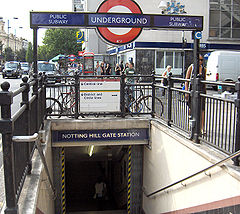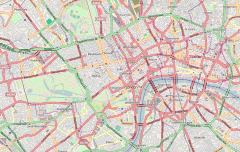- Notting Hill Gate tube station
-
Notting Hill Gate 

Entrance through a subway
Location of Notting Hill Gate in Central LondonLocation Notting Hill Local authority Royal Borough of Kensington and Chelsea Managed by London Underground Number of platforms 4 Fare zone 1 and 2 London Underground annual entry and exit 2008  16.850 million[1]
16.850 million[1]2009  17.365 million[1]
17.365 million[1]2010  17.880 million[1]
17.880 million[1]1868 Opened (MR) 1900 Opened (CLR) List of stations Underground · National Rail Coordinates: 51°30′32″N 0°11′49″W / 51.509°N 0.197°W
Notting Hill Gate tube station is a London Underground station in the street known as Notting Hill Gate. On the Central Line, it is between Holland Park to the west and Queensway to the east. On the District Line and Circle Line it is between High Street Kensington and Bayswater stations. It is on the boundary of Travelcard Zone 1 and Zone 2.
Contents
History
The sub-surface Circle and District line platforms were opened on 1 October 1868 by the Metropolitan Railway (MR) as part of its extension from Paddington to Gloucester Road. The Central line platforms were opened on 30 July 1900 by the Central London Railway (CLR). Entrances to the two sets of platforms were originally via separate station buildings on opposite sides of the road and access to the CLR platforms was originally via lifts.
The station name Notting Hill Gate had potential for confusion with the MR station to the north in Ladbroke Grove which was known as "Notting Hill" when opened in 1864, and renamed "Notting Hill & Ladbroke Grove" in 1880. This latter station eventually, in 1919, dropped its reference to Notting Hill, becoming "Ladbroke Grove (North Kensington)" in 1919 and, simply, "Ladbroke Grove" in 1938 (see Ladbroke Grove tube station).
Redevelopment
The station was rebuilt in the late 1950s and reopened on 1 March 1959 linking the two 'Notting Hill Gate stations' on the Circle and District and Central lines, which had previously been accessed on either side of the street, with a shared sub-surface ticket hall with escalators down to the Central lines. The escalators were the first on the Underground to have metal side panels rather than wooden. The new entrance also acts as a pedestrian subway under the widened Notting Hill Gate.
Modernisation
The station is currently, in 2010-11, undergoing modernisation that will see new ceramic tile finishes throughout the subway entrances, deep-level passageways and Central line tube platforms as well as a modified ticket hall layout.
During works a section of lift passageways, from the original 1900 CLR station and that was abandoned during the 1959 reconstruction, was rediscovered and found to contain a series of original posters. Images have been posted here Old posters at Notting Hill Gate station
A scheme was developed by the architects Weston Williamson to provide canopies over the entrances from the street,[2] but this has not been implemented.
Nearby places
- Portobello Road, famous for Portobello Market
- Kensington Palace Gardens
Media appearances
In the 1968 film 'Otley', one of the Central Line platforms at Notting Hill Gate (or a station pretending to be it) is where assassin and coach driver Johnston, played by Leonard Rossiter, blows himself up opening a booby-trapped suitcase full of money.
Layout
The westbound Central Line platform is located above the eastbound platform because when the CLR was built it did not want to tunnel under buildings, and the street above was not wide enough for the two platforms to be side-by-side.
Transport links
London bus routes 27, 28, 31, 52, 70, 94, 148, 328, 390, 452, night routes N28, N31, N52, N207 and Oxford tube coaches.
Gallery
References
- ^ a b c "Customer metrics: entries and exits". London Underground performance update. Transport for London. 2003-2010. http://www.tfl.gov.uk/tfl/corporate/modesoftransport/tube/performance/default.asp?onload=entryexit. Retrieved 8 May 2011.
- ^ "London Underground Entrance Canopies". Weston Williamson Architects. http://www.westonwilliamson.com/projects.php?a=central_line_canopies. Retrieved 28 April 2011.
External links
Preceding station  London Underground
London UndergroundFollowing station towards Ealing Broadway or West RuislipCentral line towards Hammersmith (via Tower Hill)Circle line towards Edgware Roadtowards WimbledonDistrict line Central line Stations Bank · Barkingside · Bethnal Green · Bond Street · Buckhurst Hill · Chancery Lane · Chigwell · Debden · Ealing Broadway
· Barkingside · Bethnal Green · Bond Street · Buckhurst Hill · Chancery Lane · Chigwell · Debden · Ealing Broadway  · East Acton · Epping · Fairlop · Gants Hill · Grange Hill · Greenford
· East Acton · Epping · Fairlop · Gants Hill · Grange Hill · Greenford  · Hainault · Hanger Lane · Holborn · Holland Park · Lancaster Gate · Leyton · Leytonstone · Liverpool Street
· Hainault · Hanger Lane · Holborn · Holland Park · Lancaster Gate · Leyton · Leytonstone · Liverpool Street  · Loughton · Marble Arch · Mile End · Newbury Park · North Acton · Northolt · Notting Hill Gate · Oxford Circus · Perivale · Queensway · Redbridge · Roding Valley · Ruislip Gardens · St Paul's · Shepherd's Bush
· Loughton · Marble Arch · Mile End · Newbury Park · North Acton · Northolt · Notting Hill Gate · Oxford Circus · Perivale · Queensway · Redbridge · Roding Valley · Ruislip Gardens · St Paul's · Shepherd's Bush 
 · Snaresbrook · South Ruislip · South Woodford · Stratford
· Snaresbrook · South Ruislip · South Woodford · Stratford 

 · Theydon Bois · Tottenham Court Road · Wanstead · West Acton · West Ruislip
· Theydon Bois · Tottenham Court Road · Wanstead · West Acton · West Ruislip  · White City · Woodford
· White City · Woodford

Click to enlargeRolling stock History Former stationsFormer companiesAbandoned plansFormer rolling stockProposed stations First Central · UxbridgeCircle line Stations Aldgate · Baker Street · Barbican · Bayswater ·Blackfriars · Cannon Street
· Cannon Street  · Edgware Road · Embankment · Euston Square · Farringdon
· Edgware Road · Embankment · Euston Square · Farringdon  · Goldhawk Road · Gloucester Road · Great Portland Street · Hammersmith · High Street Kensington · King's Cross St. Pancras
· Goldhawk Road · Gloucester Road · Great Portland Street · Hammersmith · High Street Kensington · King's Cross St. Pancras  · Ladbroke Grove · Latimer Road · Liverpool Street
· Ladbroke Grove · Latimer Road · Liverpool Street  · Mansion House · Monument (
· Mansion House · Monument ( Bank) · Moorgate
Bank) · Moorgate  · Notting Hill Gate · Paddington
· Notting Hill Gate · Paddington  · Royal Oak · Shepherd's Bush Market · Sloane Square · South Kensington · St. James's Park · Temple · Tower Hill (
· Royal Oak · Shepherd's Bush Market · Sloane Square · South Kensington · St. James's Park · Temple · Tower Hill ( Tower Gateway) · Victoria
Tower Gateway) · Victoria  · Westbourne Park · Westminster · Wood Lane
· Westbourne Park · Westminster · Wood Lane

Click to enlargeRolling stock History Former companiesAssociated circle linesFuture proposals Future rolling stockSee also Categories:- Rail transport stations in London fare zone 1
- Rail transport stations in London fare zone 2
- Circle Line stations
- District Line stations
- Central Line stations
- Tube stations in Kensington and Chelsea
- Former Metropolitan Railway stations
- Railway stations opened in 1868
- Former Central London Railway stations
- Railway stations opened in 1900
Wikimedia Foundation. 2010.







